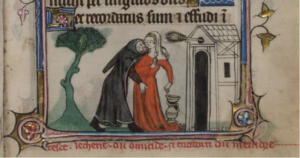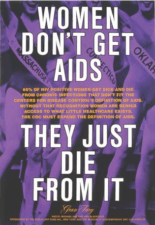Content warning: this post contains discussion of sexual violence
Eleven years after it was founded by survivor and activist Tarana Burke, the #MeToo movement exploded in 2017 following the exposure of numerous sexual-abuse allegations against Harvey Weinstein. The movement, energised by millions of survivors sharing their experiences on social media, aims to create space for these survivors to tell their stories, be heard, and most importantly believed. As a lesson for historians, we must ask ourselves how we can apply the lessons of the #MeToo movement to grant historical survivors the respect, understanding, and credibility they might not have received in their own time, particularly give the reluctance to believe women today.
It’s not easy to discuss medieval sexual violence, especially because our access to women’s stories is so limited. Evidence of medieval rape in England survives in the form of allegations of raptus – an ambiguous criminal offence, which translates from Latin as ‘seizure’ but was used to refer to a crime involving abduction and/or sexual violence, distinguishable only by context.
English women have been bringing cases of rape to court since they were first given the right eight hundred years ago. My research starts from the premise that these women were telling the truth, because the idea that women often falsely accuse men of rape is one of the foundational myths of rape culture. Too often, we are not only trying to piece together ‘what happened’, but also contending with the challenge ‘did it happen?’ Instead of trying to answer these questions, my research asks ‘why did she bring this case?’ to explore what we might learn about women’s experience.
Records of raptus allegations brought by women are evidence that a woman bravely chose to face the social and financial costs of bringing an allegation to court. This is also evidence of courage in face of the risk that she herself would be imprisoned or fined if she was found to have appealed wrongly or falsely. We must also remember that when a woman was assaulted, legal definitions and processes did not matter to her or shape her experience. They only became relevant when she chose to bring an appeal to court and tell her story. The court records at the centre of my research offer a window into the story of an assault which happened outside of the courtroom and the legislative framework of raptus.
In 1282, Rose, daughter of Nicholas le Savage, appealed John de Clifford of rape before the King’s Bench in Oxfordshire. In this case, John was helped by a group of men to abduct Rose and imprison her for twenty-one months. Rose’s appeal is a narrative of what happened to her there, including that “he raped her virginity so that the aforesaid Rose departed all bloody from the aforesaid John”.
Rose shaped her story to include the usual formulaic requirements of a convincing raptus appeal as established by legal treatises up to this point: 1) emphasis on the physical violence on her body; 2) her lack of consent; 3) and the loss of her virginity. She also included intricate details: that she was brought into the room through a door which points westwards and that she had been wearing a minever robe before she was assaulted on the right-hand side of the bed.
The court initially annulled Rose’s case and she was imprisoned for appealing wrongly because, twenty-one months after she was abducted, she couldn’t name a definite date when the assault had happened. Later, the case came back to court and John was made to pay a fine of ten pounds to the King.
We can wonder how much this record reflects exactly what happened to Rose, or how true to Rose’s words the clerk’s recording is. Maybe all we can know about ‘what happened’ is that she chose to bring a case of rape to court. But given that how unlikely it was, and still is, that she would bring a false appeal – and there is no evidence that her claim was false – we should choose to believe her. Once we do that, we can move away from thinking about medieval rape cases as being only about guilt or innocence and hear the voice of a survivor.
As historians, we know about Rose only because something awful happened to her. We have no evidence to suggest that each detail of her testimony was fabricated, we have none to suggest that it was not. If we focus primarily on trying to explain or prove each of those details, especially in terms of being about adding to a legal process only aimed at getting a conviction, we run the risk of reducing Rose’s experience to secondary importance. Taking seriously Rose’s testimony as a survivor and as a woman in the courtroom we can start to empathise with her, as we should with women today, as a survivor of a traumatic assault.
My research hopes to put stories such as Rose’s in the context of medieval law, literature, religious doctrine, and pedagogy which all informed social and cultural attitudes to sexual violence for both men and women. In answer to the question, ‘how do we know what really happened’, I respond that maybe it does not matter and maybe we can never know. But we know women did choose to stand up in medieval court and declare themselves survivors, so we should believe that she survived, even if the details of her victimhood are obscure. We can start to ask bigger questions about emotions and experiences that don’t rely on proving individual details of her testimony but engage with her whole experience.
Image:The Taymouth Hours, London, British Library MS Yates Thompson 13, fol. 177 https://www.bl.uk/catalogues/illuminatedmanuscripts/ILLUMIN.ASP?Size=mid&IllID=29284
Biography: Gabrielle Schwarzmann is a PhD student at Queen Mary, University of London, supervised by Professor Miri Rubin and Professor Maksymilian Del Mar. Her research explores sexual violence through evidence from raptus cases which came before late medieval English courts. The contextualisation of these cases within an ‘emotional ecology’ of fear, shame, and trauma – produced by medieval law, literature, religious doctrine, and pedagogy – aims to facilitate the exploration of female (and male) experience of sexual violence.


